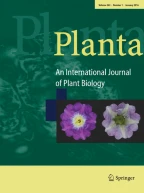Abstract.
Phytoene synthase activity in tomato chloroplasts is membrane-associated, requiring treatment with high ionic strength buffer or mild non-ionic detergent for solubilisation. Using a combination of ammonium sulphate precipitation, cation and anion exchange, dye-ligand and hydrophobic interaction chromatography, phytoene synthase has been purified 600-fold from tomato (Lycopersicon esculentum Mill.) chloroplasts. The native molecular mass of the enzyme was 43 kDa, with an isoelectric point of 4.6. Although phytoene synthase was functional in a monomeric state, under optimal native conditions it was associated with a large (at least 200 kDa) protein complex which contained other terpenoid enzymes such as isopentenyl diphosphate isomerase and geranylgeranyl diphosphate (GGPP) synthase. Both Mn2+ and ATP, in combination, were essential for catalytic activity; their effect was stochiometric from 0.5 to 2 mM, with K m values for Mn2+, ATP and the substrate GGPP of 0.4 mM, 2.0 mM and 5 μM, respectively. The detergents Tween 60 and Triton X-100 (0.1 w/v) stimulated (5-fold) enzyme activity, but lipids (crude chloroplast lipids and phospholipids) had no such effect and could not compensate for the absence of detergent. A number of metabolites with possible regulatory effects were investigated, including β-carotene, which reduced enzyme activity in vitro some 2-fold. A comparison of phytoene synthase activity from partially purified chloroplast and chromoplast preparations indicated biochemical differences.
Similar content being viewed by others
Author information
Authors and Affiliations
Additional information
Received: 20 January 2000 / Accepted: 16 February 2000
Rights and permissions
About this article
Cite this article
Fraser, P., Schuch, W. & Bramley, P. Phytoene synthase from tomato (Lycopersicon esculentum) chloroplasts – partial purification and biochemical properties. Planta 211, 361–369 (2000). https://doi.org/10.1007/s004250000293
Issue Date:
DOI: https://doi.org/10.1007/s004250000293
